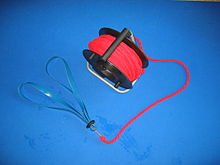Lifeline (water rescue)
The lifeline (also: lifebelt) is an aid for water rescue . The lifeline consists of a 25 to 100 meter long line with a shoulder bracket for the rescuer attached to one end. The other end is usually connected to a line reel. The lifeline is always used when the risk to the lifeguard would be too great without a safety device. This is the case, for example, with very strong currents, at weirs or when the distance to the bank is great.
application
The lifeline can only be used by a well-rehearsed team. This team consists of a line guide and a swimmer .
If it comes to a swim, the swimmer slips the shoulder strap of the line and swims to the victim.
The leash guide now takes on the task of securing and guiding the lifeguard. On the one hand, he must ensure that the line leaves the reel without interference. To do this, he lets the leash run through the hands held above his head. On the other hand, he has to make sure that he only gives enough leash so that the lifeguard can swim quickly, but does not lose contact with him. If there is too much line, the swimmer can get caught in it. In order to guide the swimmer to the casualty, the swimmer and leash handler must have agreed signals beforehand (e.g. pulling on the leash). The line operator can then use these pull signals to guide the swimmer to the casualty.
If the swimmer has now reached the casualty and has secured him, he gives the rope handler the signal to retrieve with the raised hand. The leash handler now pulls the swimmer and the casualty back with the leash. If both have arrived on the bank , the casualty is taken care of by both team members or other units.
advantages
- Rescuers do not have to spare their strength when swimming
- high safety of the rescuer due to the leash connection to the bank
- easy maintenance
- quickly ready for use with the reel
- In an emergency, it can also be made by yourself with a double bowline with a correspondingly long line
disadvantage
- constant practice and a well-coordinated team required
- no lift
- if used incorrectly, there is a high level of personal risk
- Cannot be used in heavy seas
- Operating range limited to the length of the line (up to 200 m)
- Possible tangle
